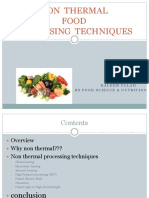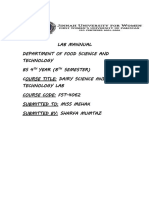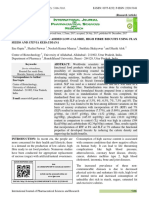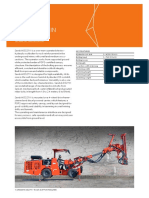Milk Pasteurization
Milk Pasteurization
Uploaded by
bhuniakanishkaCopyright:
Available Formats
Milk Pasteurization
Milk Pasteurization
Uploaded by
bhuniakanishkaOriginal Description:
Copyright
Available Formats
Share this document
Did you find this document useful?
Is this content inappropriate?
Copyright:
Available Formats
Milk Pasteurization
Milk Pasteurization
Uploaded by
bhuniakanishkaCopyright:
Available Formats
Milk Pasteurization detection using inactivation of Alkaline Phosphatase
Enzymes are organic catalysts which occur naturally in most raw foods. When milk is pasteurized
most of the enzymes are inactivated or their activity is greatly diminished. The first reliable
enzymatic test for determining efficiency of pasteurization was developed by Kay and Graham in
England in 1933. It was based upon the inactivation of alkaline phosphatase.
The phosphatase test is applied to dairy products to determine whether pasteurization was done
properly and also to detect the possible addition of raw milk to pasteurized milk. The thermal
resistance of alkaline phosphatase has been considered to be greater than that of any
nonsporeforming pathogens that might be found in milk. However, the recent outbreaks of disease
traced to Listeria monocytogenes in pasteurized milk lead one to begin to question this conclusion.
Alkaline phosphatase is a monesterase that catalyzes the hydrolysis of monoesters.
Studies have shown that the amount of alkaline phosphatase in raw milk is variable. The activity
of phosphatase per unit of milk seems to be inversely correlated to milk yield, reaching a minimum
in 1 or 2 weeks after calving and rising gradually to a maximum in about 25 weeks. Breed, feed of
the cow, or fat content of the milk do not appear to influence phosphatase activity. Alkaline
phosphatase is associated with the fat globule of milk, i.e., it is adsorbed to the fat globule
membrane surface.
Phosphatase tests currently described in Standard Methods for the Examination of Dairy Products
are based on the principle that the alkaline phosphatase enzyme in raw milk liberates phenol from
a disodium phenyl phosphate substrate (Scharer Method) or phenolphthalein from a
phenolphthalein monophosphate substrate (Rutgers Method) when tests are conducted at suitable
temperature and pH. The amount of phenol or phenolphthalein liberated from the substrate is
proportional to the activity of the enzyme. Phenol is measured calorimetrically after its reaction
with 2,6 dichloroquinone-chloroimide (CQC) to form indophenol. Phenolphthalein is detected by
addition of sodium hydroxide.
While the Scharer rapid method is relatively simple and quick, it must be recognized that it does
possess some inherent weaknesses. There is a constant hazard of phenol contamination from
reagents, glassware, and stoppers. Reagents are unstable as is the color formed by the reaction of
phenol with the dye. Visual measurement of color is sometimes difficult, particularly with
borderline cases; and emulsification frequently occurs during the extraction of the phenol with
butanol.
Phenolphthalein monophosphate is a very stable substrate which is easily hydrolyzed by alkaline
phosphatase to yield free phenolphthalein. Our studies have revealed that the use of this substrate
provides greater sensitivity than disodium phenyl phosphate. The high sensitivity is due to several
factors, namely, the ease of color comparison, the high rate of hydrolysis, the elimination of
variations because of specific color reaction and extraction, and the slight contribution of yellow
color of milk fat to the pink color of phenolphthalein.
It is necessary to run both positive and negative controls when conducting a phosphatase
procedure. A negative control is prepared by heating a product to 90C for 1 minute followed by
rapid cooling. Any color developing when a test is run on the control indicates contamination of
reagents or presence of interfering coloring materials or both. A positive control is run as a check
on the proper functioning of reagents. It is conducted by adding 0.2 ml of fresh, raw mixed-herd
milk to 100 ml of raw milk which has been heated at 90C for 1 minute, followed by rapid cooling
to room temperature. One should obtain a positive result on this test.
Another control test should be run on samples which yield positive results in the initial analysis.
This test is conducted in order to distinguish residual alkaline phosphatase from microbial alkaline
phosphatase. Microbial phosphatases are considerably more heat resistant than is alkaline milk
phosphatase. Therefore, it is possible to differentiate these enzymes by pasteurization of the sample
in question and retesting. If there is no significant difference in the results of the test, one then
concludes that the original positive result was due to microbial phosphatase.
Reactivated phosphatase sometimes occurs in high fat dairy products which have been
ultrapasteurized, such reactivation occurring quickly when samples are stored at non-refrigerated
(70-90F) temperatures. A test has been developed which permits one to distinguish residual from
reactivated alkaline phosphatase.
Alkaline phosphatase methodology is applicable to cheese. However, consideration must be given
to the possibility of obtaining false-positive tests due to the possible presence of mold in the cheese.
In the early 1940's, Scharer reported as follows: "Our recent work has indicated that yeast and
some molds (a culture of Oidium lactis and Penicillium notatum) which grown on cheese under
certain conditions will produce appreciable amounts of phosphatase, but that if the mold growth is
removed before the cheese sample is prepared for testing purpose, no difficulty or false positive is
encountered." Thus, sampling of cheese is a very important consideration, i.e., one must be certain
that no mold is evident. In addition, it is highly recommended that cheese be sampled before the
addition of condiments such as peppers or spices as these materials may also be responsible for
false positive tests. Ideally, cheese samples should be placed in clean containers, refrigerated, and
tested within 36 hours in order to be certain that no development of microbial phosphatase has
occurred. Finally, if cheese is not properly stored in the marketplace there is a possibility that
microbial growth may occur which could result in false positive results for the alkaline
phosphatase test. Thus, sampling of cheese for phosphatase analysis should be conducted before
cheese enters marketing channels.
ALKALINE PHOSPHATASE METHODOLOGY
Dick H. Kleyn, Ph.D.,
Dept. of Food Science
Rutgers University
New Brunswick, NJ 08903
You might also like
- WoodPlans Online - Crown Molding BoxesDocument9 pagesWoodPlans Online - Crown Molding BoxesЧедомир Арнаут100% (10)
- E HaccpDocument120 pagesE HaccpKiran GadmaleNo ratings yet
- Troubleshooting Milk Flavor Problems - Dairy Cattle Nutrition - Penn State ExtensionDocument7 pagesTroubleshooting Milk Flavor Problems - Dairy Cattle Nutrition - Penn State ExtensionCostaEdvaldoNo ratings yet
- Food Analysis ManualDocument70 pagesFood Analysis ManualRishad KalappurakkalNo ratings yet
- Hilfiger Watch ManualDocument26 pagesHilfiger Watch ManualbhuniakanishkaNo ratings yet
- Solar Radiation Effect On Crop ProductionDocument29 pagesSolar Radiation Effect On Crop ProductionbhuniakanishkaNo ratings yet
- B 374 KDocument14 pagesB 374 Kmgrin30No ratings yet
- Unit 12 What Are Scientific Facts?Document28 pagesUnit 12 What Are Scientific Facts?Kenton LyndsNo ratings yet
- Quality Issues of Milk & Milk Products (17-Uglc-603)Document22 pagesQuality Issues of Milk & Milk Products (17-Uglc-603)ayesha shafiqueNo ratings yet
- PasteurizationDocument3 pagesPasteurizationDEV1997No ratings yet
- Advanced Food Analysis FST515-N 3Document105 pagesAdvanced Food Analysis FST515-N 3Tilahun AberaNo ratings yet
- Lecture 2 Properties of Milk and Its ComponentsDocument10 pagesLecture 2 Properties of Milk and Its ComponentsAyush Chopra0% (1)
- Figure 2: Hydrolysis of Sucrose (Averill & Eldredge, 2013)Document5 pagesFigure 2: Hydrolysis of Sucrose (Averill & Eldredge, 2013)Hafiidz MalekNo ratings yet
- Review On Hazard Analysis and Critical Control PoiDocument17 pagesReview On Hazard Analysis and Critical Control PoiMutiaraniNo ratings yet
- The Frying Process: Università Degli Studi Di ParmaDocument13 pagesThe Frying Process: Università Degli Studi Di ParmarinthusNo ratings yet
- Food Microbiology and Parasito - Ms Grace Rukwaro - 14120Document28 pagesFood Microbiology and Parasito - Ms Grace Rukwaro - 14120Edward MakemboNo ratings yet
- Advantages of Solid State Fermentation Over Submerged FermentationDocument32 pagesAdvantages of Solid State Fermentation Over Submerged Fermentationtelangsachin12No ratings yet
- Modified Atmosphere PackagingDocument17 pagesModified Atmosphere PackagingMaryam ZaraNo ratings yet
- Production of Instant Soymilk Powders by Ultra Ltration, SprayDocument12 pagesProduction of Instant Soymilk Powders by Ultra Ltration, SprayNguyễn Quang100% (2)
- Effect of Sprouting On Nutritional Quality of PulsesDocument12 pagesEffect of Sprouting On Nutritional Quality of PulsesRadwan AjoNo ratings yet
- Leaflet - Milk FermentationDocument3 pagesLeaflet - Milk FermentationNoor SultanNo ratings yet
- Lely Dairy Equipment 2014 - en PDFDocument92 pagesLely Dairy Equipment 2014 - en PDFelizasunderNo ratings yet
- Deep Fat Frying of PotatoDocument60 pagesDeep Fat Frying of PotatoKhaled Abu-AlruzNo ratings yet
- Downstream Processing Ppt1Document17 pagesDownstream Processing Ppt1Garima AwasthiNo ratings yet
- Fruit and Vegetable Processing Plant Sanitation 2018Document16 pagesFruit and Vegetable Processing Plant Sanitation 2018Reza Sukma100% (1)
- ProbioticsDocument18 pagesProbioticsBig BrosNo ratings yet
- Pulsed Electric Field Processing of FoodsDocument30 pagesPulsed Electric Field Processing of FoodsMohammad Ishfaq BhatNo ratings yet
- Assignment Food Safety Regulation: Topic: Potato ChipsDocument8 pagesAssignment Food Safety Regulation: Topic: Potato Chipsinfo tamilNo ratings yet
- Direct Spray Drying and Microencapsulation of Probiotic Lactobacillus Reuteri From Slurry Fermentation With Whey PDFDocument8 pagesDirect Spray Drying and Microencapsulation of Probiotic Lactobacillus Reuteri From Slurry Fermentation With Whey PDFpniramolNo ratings yet
- The Kombucha Biofilm: A Model System For Microbial EcologyDocument19 pagesThe Kombucha Biofilm: A Model System For Microbial EcologyPachi BertaNo ratings yet
- Food PreservationDocument61 pagesFood PreservationKumkum CrNo ratings yet
- Acidity of Fruits and VegetablesDocument18 pagesAcidity of Fruits and VegetablesHarish ChandranNo ratings yet
- Microbiology of Khoa and Khoa Based ProductsDocument9 pagesMicrobiology of Khoa and Khoa Based Productsshraddha dubeyNo ratings yet
- Non Thermal Food Processing Techniques: Present By: Kaleemullah Bs Food Science & NutritionDocument17 pagesNon Thermal Food Processing Techniques: Present By: Kaleemullah Bs Food Science & Nutritionkaleem100% (1)
- Yeast Extract PDFDocument1 pageYeast Extract PDFtaiar2010No ratings yet
- Dairy Chapter 1 PDFDocument76 pagesDairy Chapter 1 PDFSteven LiberatoNo ratings yet
- Development and Quality Evaluation of Probiotic ShrikhandDocument9 pagesDevelopment and Quality Evaluation of Probiotic ShrikhandIndian Journal of Veterinary and Animal Sciences RNo ratings yet
- Food Fermentation: Enzyme ProductionDocument9 pagesFood Fermentation: Enzyme ProductionSweettha GunasekaranNo ratings yet
- Quality Management Systems in Dairy Industry PDFDocument9 pagesQuality Management Systems in Dairy Industry PDFDeiscy ContrerasNo ratings yet
- Water Use in Food IndustryDocument8 pagesWater Use in Food IndustryHisExcellencyNo ratings yet
- Module 1. Introduction To Fat Rich Dairy ProductsDocument3 pagesModule 1. Introduction To Fat Rich Dairy ProductsEasy ways2017No ratings yet
- Waste Water Disposal and Pollution Control in DairyDocument14 pagesWaste Water Disposal and Pollution Control in Dairy19 CH 056 Vaishali Vivek100% (1)
- Dairy Lab Mannual CompleteDocument40 pagesDairy Lab Mannual CompleteZarakhankhan KhanNo ratings yet
- Milk Sampling and TestingDocument8 pagesMilk Sampling and Testingjinalsinh1No ratings yet
- UHT Milkaseptic PackagingDocument44 pagesUHT Milkaseptic PackagingĐivềphía Mặt TrờiNo ratings yet
- Advancement in Traditional Heat Desiccated Dairy ProductDocument32 pagesAdvancement in Traditional Heat Desiccated Dairy Productaparnna vpNo ratings yet
- Use of Microorganisms For The Production of Amino Acids - Mubasshira-MSc-2 FPPDocument45 pagesUse of Microorganisms For The Production of Amino Acids - Mubasshira-MSc-2 FPPdrashti shahNo ratings yet
- Study On Preservation of Meat and Meat Products by Smoking.Document33 pagesStudy On Preservation of Meat and Meat Products by Smoking.Bt JewelNo ratings yet
- Formulation of Value Added Low-Calorie, High Fibre Biscuits Using Flax Seeds and Stevia RebaudianaDocument8 pagesFormulation of Value Added Low-Calorie, High Fibre Biscuits Using Flax Seeds and Stevia Rebaudianascience worldNo ratings yet
- Study of HACCP Implementation in Milk Processing PDocument6 pagesStudy of HACCP Implementation in Milk Processing PHamada H. ShaatNo ratings yet
- Practical Hygiene and Disinfection On Dairy FarmsDocument14 pagesPractical Hygiene and Disinfection On Dairy FarmsAdela PopescuNo ratings yet
- Factors Affecting Growth of MicroorganismDocument16 pagesFactors Affecting Growth of MicroorganismTanmoy PramanikNo ratings yet
- Env3 - Kraft, Environmental Monitoring Program PDFDocument37 pagesEnv3 - Kraft, Environmental Monitoring Program PDFMarianyNo ratings yet
- Khoa ManufactureDocument11 pagesKhoa Manufactureanur3a31No ratings yet
- CHBH13 - Laboratory Manual 4Document8 pagesCHBH13 - Laboratory Manual 4Ysa DienteNo ratings yet
- Yeast ExtractsDocument3 pagesYeast ExtractsSorindah MolinaNo ratings yet
- Concept Importance and Types of Starter Cultures in Dairy IndustryDocument21 pagesConcept Importance and Types of Starter Cultures in Dairy IndustryRohit Pandey0% (1)
- Lecture 2 Emerging Technologies in Food Processing MeatDocument22 pagesLecture 2 Emerging Technologies in Food Processing MeatAyesha MunawarNo ratings yet
- Advanced Dairy Science and TechnologyFrom EverandAdvanced Dairy Science and TechnologyTrevor BritzNo ratings yet
- Microbiology in Dairy Processing: Challenges and OpportunitiesFrom EverandMicrobiology in Dairy Processing: Challenges and OpportunitiesNo ratings yet
- Advances in Dairy ProductsFrom EverandAdvances in Dairy ProductsFrancesco ContoNo ratings yet
- Pi Is 0022030232934080Document12 pagesPi Is 0022030232934080Laksmi DwiNo ratings yet
- Fosfatasa ReviewDocument14 pagesFosfatasa Reviewkarmasnm787No ratings yet
- Package Nlsmicrobio'Document16 pagesPackage Nlsmicrobio'bhuniakanishkaNo ratings yet
- Computational Fluid Dynamics (CFD) Modeling of Grain-Water Suspensions in TubeDocument15 pagesComputational Fluid Dynamics (CFD) Modeling of Grain-Water Suspensions in TubebhuniakanishkaNo ratings yet
- Differential Equations in R: Tutorial User Conference 2011Document99 pagesDifferential Equations in R: Tutorial User Conference 2011bhuniakanishkaNo ratings yet
- Package Nlstools': R Topics DocumentedDocument18 pagesPackage Nlstools': R Topics DocumentedbhuniakanishkaNo ratings yet
- Monte Carlo Methods PDFDocument6 pagesMonte Carlo Methods PDFbhuniakanishkaNo ratings yet
- Unidirectional Transport: 3.1 Solutions of The Diffusion EquationDocument41 pagesUnidirectional Transport: 3.1 Solutions of The Diffusion EquationbhuniakanishkaNo ratings yet
- dsc12 HuDocument17 pagesdsc12 HubhuniakanishkaNo ratings yet
- Diffusion Mass TransferDocument18 pagesDiffusion Mass TransferbhuniakanishkaNo ratings yet
- Phase Equilibrium: When A Gas and A Liquid Phase Which Are Not Thermodynamically inDocument17 pagesPhase Equilibrium: When A Gas and A Liquid Phase Which Are Not Thermodynamically inbhuniakanishkaNo ratings yet
- Separation of Isopropanol From Aqueous Solution by Salting-Out ExtractionDocument7 pagesSeparation of Isopropanol From Aqueous Solution by Salting-Out ExtractionbhuniakanishkaNo ratings yet
- SCOPE OF SUPPLY, Kaz Minerals - Peschanka MineDocument13 pagesSCOPE OF SUPPLY, Kaz Minerals - Peschanka MineldwNo ratings yet
- GX Works2 Brochure - L08122efDocument48 pagesGX Works2 Brochure - L08122efsiprian12332No ratings yet
- P94-1864 Control de PuertasDocument4 pagesP94-1864 Control de PuertasGonzalo Galvez0% (1)
- How To Calibration Raylase ScanheadDocument9 pagesHow To Calibration Raylase ScanheadliantuangNo ratings yet
- DS2711 Narrow Vein Bolter: Technical SpecificationDocument4 pagesDS2711 Narrow Vein Bolter: Technical SpecificationMarioNo ratings yet
- Chapter 18 Limits - PDF 2Document5 pagesChapter 18 Limits - PDF 2Likhitaa KNo ratings yet
- Matrix Structural Analysis (Truss)Document88 pagesMatrix Structural Analysis (Truss)Kristine May Maturan100% (4)
- Material Selection For PipingDocument50 pagesMaterial Selection For PipingCalcgen EngineeringNo ratings yet
- Retrofit Assessment ChecklistDocument8 pagesRetrofit Assessment ChecklistPrakash SIngh RawalNo ratings yet
- Exergy Study of Amine Regeneration Unit For Diethanolamine Used in Refining Gas Sweetening: A Real Start-Up PlantDocument12 pagesExergy Study of Amine Regeneration Unit For Diethanolamine Used in Refining Gas Sweetening: A Real Start-Up PlantMuhammad RaihanNo ratings yet
- Reinforcing Mesh Bars Trench MeshDocument1 pageReinforcing Mesh Bars Trench MeshThaiNguyenNo ratings yet
- Soil-Structure Interaction For Deeply Buried Corrugated PVC and Steel PipesDocument128 pagesSoil-Structure Interaction For Deeply Buried Corrugated PVC and Steel Pipesgulilero_yoNo ratings yet
- Class 30 - Replacement AnalysisDocument14 pagesClass 30 - Replacement Analysispraveen bavanaNo ratings yet
- Part - Kobelco SK07 N2Document3 pagesPart - Kobelco SK07 N2boy qsiNo ratings yet
- FlameGard 5 UVIR Data Sheet - EN PDFDocument2 pagesFlameGard 5 UVIR Data Sheet - EN PDFwhauckNo ratings yet
- Photosynthesis QuestionsDocument26 pagesPhotosynthesis QuestionssingamroopaNo ratings yet
- Energy Balance CalculationDocument2 pagesEnergy Balance CalculationSzelee KuekNo ratings yet
- 4BCh06 (Basic Properties of Circles 1)Document37 pages4BCh06 (Basic Properties of Circles 1)api-19856023No ratings yet
- State of Charge of An BateryDocument69 pagesState of Charge of An BateryBogdan AdeleanNo ratings yet
- ANNOTATED 8 - SteviolDocument7 pagesANNOTATED 8 - SteviolKen MendozaNo ratings yet
- Brochure Ec200d t3 en 30 20057301 BDocument16 pagesBrochure Ec200d t3 en 30 20057301 BRidho PangestuNo ratings yet
- Innerlynx Installation Instructions: Advance Products & Systems, Inc. at 800-315-6009Document1 pageInnerlynx Installation Instructions: Advance Products & Systems, Inc. at 800-315-6009Anonymous Dp4DdscGSNo ratings yet
- Impact of Employees Workplace Environment On Employees PerformanceDocument14 pagesImpact of Employees Workplace Environment On Employees PerformanceLuis Gerardo BranNo ratings yet
- Take-Off Field LengthDocument4 pagesTake-Off Field LengthErvina Ahyudanari100% (1)
- Tut 1Document2 pagesTut 1me21b105No ratings yet
- XAF Entity FrameworkDocument7 pagesXAF Entity FrameworkBin RashidNo ratings yet
- Model: 40EKOZD 35efkozd: 60 HZ 50 HZ 3-Phase DieselDocument4 pagesModel: 40EKOZD 35efkozd: 60 HZ 50 HZ 3-Phase DieselsebastianNo ratings yet





































































































